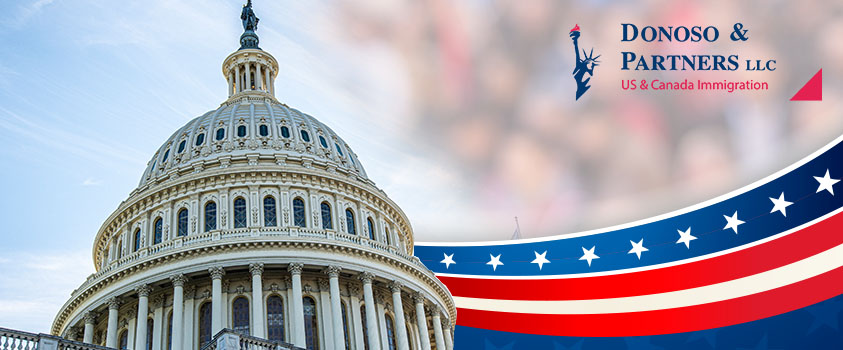
29 Jun What to Expect: EB-5 Regional Center Program Sunsets on 06-30-2021
Washington, D.C., June 29, 2021: The EB-5 Regional Center program will lapse on June 30, 2021 because the US Congress and the President did not approve an extension of the program before that date.
The following is a blog by Ignacio Donoso, Managing Partner of Donoso & Partners, on the future of the EB-5 Regional Center program and the practical impact of the program’s sunset on pending and future EB-5 petitions.
1. Path Towards Extension of the EB-5 Regional Center Program
The US Senate is now on vacation (called a “recess”) from June 25, 2021 until July 9, 2021. The US Senate returns in mid-July and then works until August 9, 2021. Then the Senate again goes on recess until September 10, 2021. Thus, there are few weeks during July and August 2021 for the US Senate to approve a bill to extend the EB-5 Regional Center program.
In terms of legislation, the US Senate did vote on a stand-alone EB-5 bill (S.831 sponsored by Senators Grassley and Leahy) to extend the EB-5 program before the June 25, 2021 recess. S.831 was not passed. The version of S.831 that was actually voted-on by the Senate proposed a 2.5 year extension of the EB-5 Regional Center program. It was not supported by the Majority Leader of the US Senate, Senator Schumer. Thus, it was proposed through a measure that required unanimous approval of all 100 senators to pass. It failed. Senator Graham issued the first vote against S.831, which doomed its fate.
So, there is no clear path forward for S.831 as it is presently written. The reasons for this are because (1) it creates significant regulatory oversight by USCIS over regional centers and foreign sales agents, and (2) does not deal with key problems in the program including waiting lists.
It is likely that the renewal of the EB-5 Program will occur by attaching a “clean” extension of the EB-5 Program (with no changes from the current program) to either the infrastructure bill or a Continuing Budget Resolution required to keep the US federal government funded and operating. It is unlikely that S.831 or any other stand-alone bill on the EB-5 program will pass due to domestic political issues relating to the politics of immigration in the US.
At the same time, there is support in the US Congress for the EB-5 Program. Senator Schumer, Senator Cornyn, Graham, Leahy and Grassley are all on record as supporting the EB-5 program. The issue is that they have not agreed on how best to reform the program. Thus, the likelihood of the EB-5 program not being renewed is low.
The way forward thus has two parts: (1) lapse in the EB-5 Regional Center program, and (2) new legislation.
2. Impact of Lapse of the EB-5 Regional Center Program
On a short-term basis, the EB-5 Regional Center program will lapse from June 30, 2021 until such date as the US Congress and US President pass new legislation extending the program.
(i) Expected Duration of Lapse
The lapse is expected to last for at least 2-3 weeks and possibly up until October of 2021 – which is when the Continuing Budget Resolutions have to be passed by the US Congress and signed by the US President.
(ii) New I-526 Petitions Based on Regional Center Investments
During the lapse, USCIS will likely: (a) continue to accept new Regional Center-based I-526 visa petitions filed under the regulations that were in effect before November 21, 2019; (b) hold such visa petitions without issuing receipt notices or charging the USCIS filing fees (referred to as “holding in abeyance”). The expectation by USCIS appears to be that the US Congress and the US President will in the near-term agree to extend the EB-5 Regional Center program. I have read reports that Senator Schumer, Majority Leader of the US Senate, has sent USCIS a letter stating that USCIS should work on the assumption that the EB-5 Regional Center program will be renewed.
New Regional Center-based I-526 petitions held in abeyance will be in a tricky spot. We will have FedEx delivery confirmation that the I-526 package was delivered to the USCIS Lock Box, and then nothing else. This could go on for weeks. Again, when USCIS holds a new petition in abeyance, the USCIS does nothing with the case (no fees charged; no receipt notices issued).
If the USCIS does not use the abeyance policy, then new I-526 petitions based on regional center investments filed during the lapse in the program will be rejected and sent back to the petitioner, unopened and unprocessed.
(iii) Pending I-526 Petitions Based on Regional Center Investments
During the lapse in the EB-5 Regional Center program, USCIS is likely going to continue processing pending I-526 visa petitions but will not issue any approvals or Requests for Evidence (RFE’s) for Regional Center-based I-526 petitions.
(iv) US Consulate Interviews for I-526 Petitions Based on Regional Center Investments
It is likely that US Consulates will postpone EB-5 visa interviews based on Regional Center investments during the lapse. Investors should be prepared for this possibility. As of now, the US Department of State has not issued such a notice (whether generally or individual to any of our clients). Nevertheless, this is what happened the last time the EB-5 Regional Center program lapsed during the federal government shut-down in Dec. 2018 and Jan. 2019. The issue is not visa availability as much as statistical job-creation methodologies that are essential to the EB-5 Regional Center program, and which do not exist in the Direct EB-5 program.
(v) US Adjustment of Status Applications for I-526 Petitions Based on Regional Center Investments
It is likely that USCIS will continue to process I-485 Applications for Adjustment of Status during the lapse, but will not issue Adjustment of Status interviews or RFE’s, and there may be delays in renewal of I-131 travel permits and I-765 temporary work authorizations.
(vi) New I-526 Petitions Based on Direct EB-5 Investments
During the lapse, USCIS will continue to process Direct EB-5 petitions normally and without interruption. USCIS will continue to accept new Direct EB-5 petitions based on the old regulations pre-November 21, 2019. USCIS will continue to process pending Direct EB-5 I-526 petitions normally, including issuing approvals or RFE’s. USCIS will also continue processing I-485 Applications for Adjustment of Status based on Direct EB-5 investments.
Finally, the US Department of State and US Consulates will also continue to process pending or new EB-5 petitions based on Direct EB-5 investments at US Consular posts all over the world.
(vii) I-829 Petitions for Both Regional Center Investments and Direct EB-5 Investments
Based on prior statements by USCIS, we expect USCIS to continue processing I-829 petitions without interruption during the lapse in the EB-5 Regional Center program. This applies to both Regional Center-based EB-5 petitions and Direct EB-5 petitions. Thus, USCIS will continue to issue approvals or RFE’s relating to I-829 petitions during the lapse. New I-829 petitions can be properly filed during the lapse and will be processed by USCIS including issuing receipt notices and charging fees. They will not be held in abeyance.
(viii) What Happens if the EB-5 Regional Center Program is Not Renewed?
In this very extreme situation, USCIS will be forced to issue RFE’s for any I-526s or I-485s or US Consulate cases that have not already been approved for Conditional Lawful Permanent Residence regarding the job-creation requirements of the EB-5 program. The issue will be the statistical job-creation methodologies that are essential to the EB-5 Regional Center program, and which do not exist in the Direct EB-5 program. These RFE’s will eventually lead to the denial of nearly all pending I-526 petitions that have not been approved before the lapse. Again, this very extreme situation is unlikely to occur.
3. New Legislation
The US Congress is likely to extend the EB-5 Regional Center program with no changes through either the infrastructure bill or a Continuing Budget Resolution. This should occur at the latest by October 2021.
As stated above, it is very unlikely that a stand-alone EB-5 bill will pass the US Senate. This was demonstrated by the failure to pass S.831 on June 24, 2021. Senators Grassley and Leahy will likely continue to insist on something similar to S.831 in the future. Nevertheless, under the Senate leadership of Senator Schumer, it is likely that they will be told clearly to ‘make a deal’ with Senators who do not agree with their vision if they want to succeed in their reforms. I suspect, in fact, that they were already told to ‘make a deal’ back in January 2021 (when Senator Schumer took over the Senate Majority) and refused to make significant concessions to opposing views.
Senators Grassley and Leahy do retain some bargaining power and should not be discounted. Their main bargaining power is their potential opposition to the renewal of the EB-5 program. In the case of Senator Grassley, that has always been something he makes very clear. That is why it is likely that a renewal of the EB-5 program will pass through approval of a very important bill such as infrastructure investment or a Continuing Budget Resolution. Such bills are referred to as “must pass” legislation, which requires Senators to vote in favor of the bill even if it contains some minor bills that are not to their liking, such as an extension of the EB-5 Regional Center program with no changes.
4. New Regulations
The potential for new EB-5 Regulations is very real. It will take, however, many months to take shape. The USCIS is presently without its new Director. The nomination of the new Director is expected to be finally approved by the US Senate in July 2021. I very much doubt that new regulations will be initiated until the new USCIS Director is confirmed by the US Senate.
Additionally, potential new EB-5 Regulations will be delayed until the renewal of the EB-5 Regional Center program is confirmed. That could take until October 2021. Thus, my estimation is that a new regulatory initiative for EB-5 Regional Centers will not start until – at the earliest – October 2021 and could take most of 2022 to complete.
Finally, in relation to EB-5 litigation, it is likely that the lapse in the EB-5 Regional Center program will cause the Department of Homeland Security to wait until the last minute to file an appeal of the federal court decision in Behring Regional Center v. Wolf from last June 23, 2021. Without a Regional Center program, the appeal is likely moot. Nevertheless, the Department of Homeland Security is likely to appeal just to preserve its right of appeal.
Donoso & Partners, a leading immigration law firm based in Washington, D.C., will continue to report on developments regarding the immigration law and policy through our news section of donosolaw.com.
SCHEDULE A CONSULTATION TODAY.
Donoso & Partners, LLC provide assistance with review and advice regarding eligibility for visas to the U.S. or Canada.



Sorry, the comment form is closed at this time.